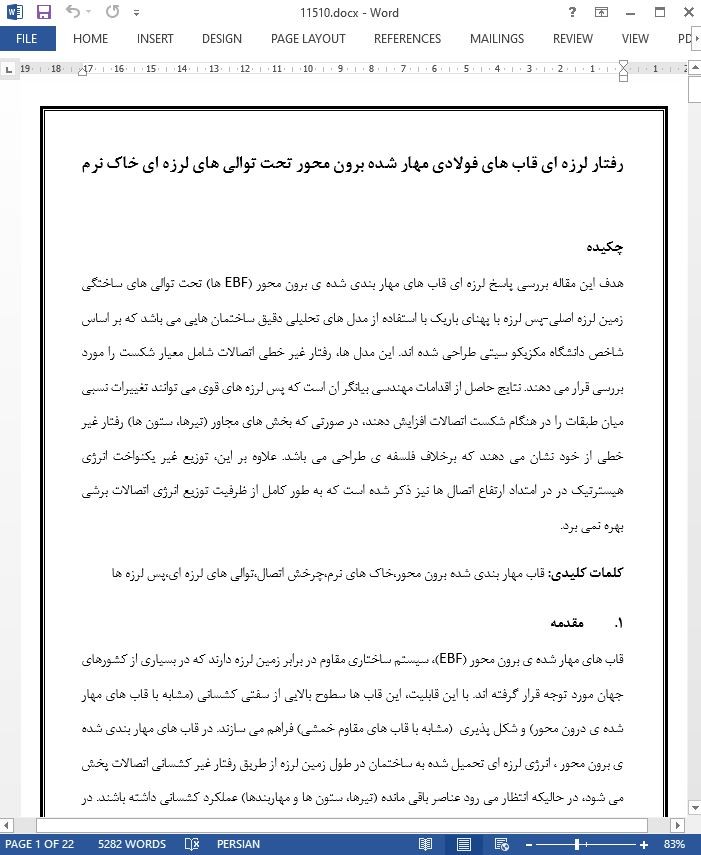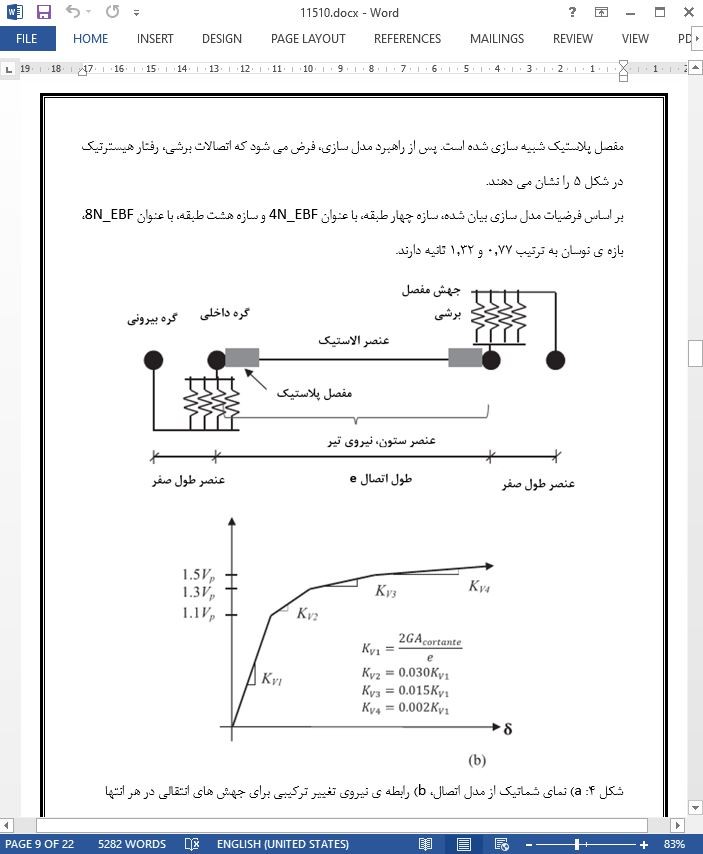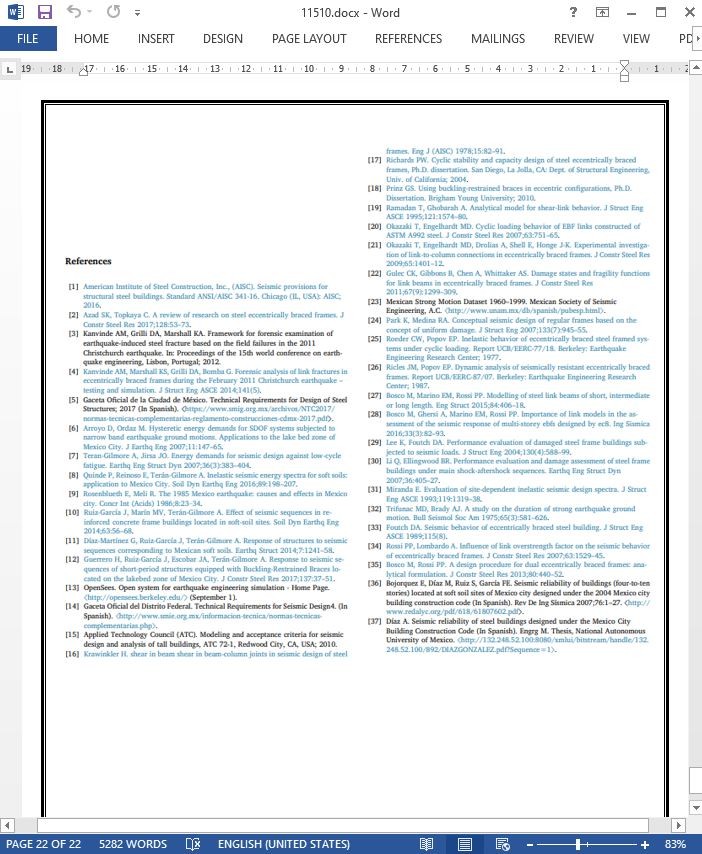
رفتار لرزه ای قاب های فولادی مهار شده برون محور تحت توالی های لرزه ای خاک نرم
چکیده
هدف این مقاله بررسی پاسخ لرزه ای قاب های مهار بندی شده ی برون محور (EBF ها) تحت توالی های ساختگی زمین لرزه اصلی-پس لرزه با پهنای باریک با استفاده از مدل های تحلیلی دقیق ساختمان هایی می باشد که بر اساس شاخص دانشگاه مکزیکو سیتی طراحی شده اند. این مدل ها، رفتار غیر خطی اتصالات شامل معیار شکست را مورد بررسی قرار می دهند. نتایج حاصل از اقدامات مهندسی بیانگر ان است که پس لرزه های قوی می توانند تغییرات نسبی میان طبقات را در هنگام شکست اتصالات افزایش دهند، در صورتی که بخش های مجاور (تیرها، ستون ها) رفتار غیر خطی از خود نشان می دهند که برخلاف فلسفه ی طراحی می باشد. علاوه بر این، توزیع غیر یکنواخت انرژی هیسترتیک در در امتداد ارتفاع اتصال ها نیز ذکر شده است که به طور کامل از ظرفیت توزیع انرژی اتصالات برشی بهره نمی برد.
1. مقدمه
قاب های مهار شده ی برون محور (EBF)، سیستم ساختاری مقاوم در برابر زمین لرزه دارند که در بسیاری از کشورهای جهان مورد توجه قرار گرفته اند. با این قابلیت، این قاب ها سطوح بالایی از سفتی کشسانی (مشابه با قاب های مهار شده ی درون محور) و شکل پذیری (مشابه با قاب های مقاوم خمشی) فراهم می سازند. در قاب های مهار بندی شده ی برون محور ، انرژی لرزه ای تحمیل شده به ساختمان در طول زمین لرزه از طریق رفتار غیر کشسانی اتصالات پخش می شود، در حالیکه انتظار می رود عناصر باقی مانده (تیرها، ستون ها و مهاربندها) عملکرد کشسانی داشته باشند. در حال حاضر، روش طراحی قاب های مهار بندی شده ی برون محور در (شروط لرزه ای AISC برای طراحی ساختمان های فولادی،2016) (1) ارائه شده است که در ان، طراحی اتصال، محدودیت های گردش اتصالات، و عوامل مقاومت مازاد اتصال به همراه موضوعات دیگر تعیین شده است. به عنوان مثال، چرخش اتصال محدود به 0.08 رادیان برای اتصالات در برش است (یعنی اتصالات دارای طول برابر یا کمتر از ، که و لنگر خمشی پلاستیک و مقاومت برشی پلاستیک اتصال می باشند).بررسی کلی پژوهش های تجربی و تحلیلی انجام شده در زمینه ی قاب های فولادی مهار شده ی برون محور در رفرنس (2) ارائه شده است.
5. خلاصه و نتیجه گیری
این مقاله، عملکرد لرزه ای دو قاب فولادی مهار بندی شده ی برون محور (EBF) را که بطور فرضی روی یک منطقه ی خاک نرم در مکزیکو سیتی بنا شده اند بررسی نمود. این قاب ها مطابق با الزامات سفتی و استحکام شاخص های دانشگاه مکزیکو سیتی در سال 2004 طراحی شدند. مدل های تحلیلی قاب های مهار بندی شده ی برون محور، تیرها، ستون ها، و مهار بندها با استفاده از رویکرد پلاستیسیته ی توزیع شده مدل سازی شدند در حالیکه اتصالات با استفاده از رویکرد مدل سازی ای که مفصل پلاستیک برشی را شبیه سازی می کرد، مدل سازی گردیدند. علاوه بر این، واکنش هیسترتیک اتصالات، معیار شکست را شامل می شد (اتصالاتی که ظرفیت برشی خود را زمانی که چرخش پلاستیک غیر کشسان برابر با 0.06 رادیان هنگام بار گیری چرخان بدست می اید، خالی می کنند)، و مطابق با واکنش ازمایشی بود. با توجه به کمبود توالی های زلزله-پس لرزه ی ثبت شده کافی با شدت متفاوت، (نسبت شدت پس لرزه با توجه به زلزله اصلی، و نیز اینکه زلزله ها مورد سنجش قرار می گیرند تا به بیشترین PGV ثبت شده برسند، این PGV همان زلزله ی 19 سپتامبر سال 1985 در مکزیکو سیتی است) به عنوان بخشی از این مطالعه ایجاد گردید.
Abstract
The goal of this paper is to examine the seismic response of eccentrically braced frames (EBFs) under artificial narrow-band mainshock-aftershock sequences by means of detailed analytical models representative of buildings designed under the Mexico City Code criteria. These analytical models take into account the nonlinear behavior of the links including a failure criterion. Relevant results for engineering practice showed that strong aftershocks could significantly increase interstory drift demands once the link fails, while surrounding members (adjacent beams, columns) behave nonlinearly, which is opposite to the design philosophy. In addition, it was noted the nonuniform distribution of hysteretic energy along-height of the links, which do not take fully advantage of the energy dissipating capacity of the shear links.
1. Introduction
Eccentrically Braced Frames (EBF) have become an attractive earthquake-resistant structural system in many countries worldwide since it provides high levels of both elastic stiffness (similar to concentrically braced frames) and ductility (similar to moment-resisting frames). In EBFs, the seismic energy induced to the building during earthquake loading is dissipated through the inelastic behavior of the links, while the remaining elements (beams, columns, and braces) are expected to behave elastically. Currently, the design procedure for EBF is prescribed in the 2016 AISC Seismic Provisions for Structural Steel Buildings [1], which specifies the link design, link rotation limits, and link overstrength factors, among other issues. Particularly, the link rotation is limited to 0.08 rad for links behaving in shear (i.e. for links with length equal or smaller than 1.6Mp/Vp, where Mp and Vp are the plastic bending moment and the plastic shear strength of the link). A comprehensive review of relevant experimental and analytical research carried out on steel eccentrically braced frames is presented in Ref. [2].
5. Summary and conclusions
This paper examined the seismic behavior of two steel eccentrically braced frames (EBF) assumed to be located at a soft soil site in Mexico City. The EBFs were designed to satisfy the lateral strength and stiffness requirements of the 2004 Edition of the Technical Requirements for Seismic Design prescribed in the Mexico City Building Construction Code. The analytical models of the EBFs, beams, columns, and braces were modeled using a distributed plasticity approach, while the links were modeled using a modeling strategy that simulate shear plastic hinges. In addition, the hysteretic response of the links considered a failure criterion (i.e. the links exhaust their shear capacity when an inelastic plastic rotation equal to 0.06 rad is reached during cyclic loading), which is consistent with its experimental response. Due to the scarcity of enough recorded mainshock-aftershock sequences at soft soil sites, three sets of artificial sequences with different intensity ratio, VA/ VM (i.e. ratio of the intensity of the aftershock with respect to the mainshock, considering that the mainshocks are scaled to reach the highest PGV recorded during the September 19, 1985 earthquake in Mexico City) were generated as part of this study
چکیده
1. مقدمه
2. ساختمان های دارای قاب مهار بندی شده ی برون محور (EBF)، نمونه ی موردی
2.1 تشریح و طراحی قاب های فوق (EBF)
2.2 مدل سازی قاب های مهار بندی شده ی برون محور نمونه
2.3 مدل سازی اتصالات
2.4 معیار شکست برای اتصالات برشی
3. توالی لرزه ای
4. نتایج
4.1 عملکرد تحت توالی های لرزه ای
4.2 تاثیر شدت حرکت زمین
5. خلاصه و نتیجه گیری
ABSTRACT
1. Introduction
2. Case-study EBF buildings
2.1. Description and design of EBFs
2.2. Modeling of the case-study EBFs
2.3. Modeling of links
2.4. Failure criterion for shear links
3. Seismic sequences
4. Results
4.1. Behavior under seismic sequences
4.2. Effect of ground motion intensity
5. Summary and conclusions
- ترجمه فارسی مقاله با فرمت ورد (word) با قابلیت ویرایش، بدون آرم سایت ای ترجمه
- ترجمه فارسی مقاله با فرمت pdf، بدون آرم سایت ای ترجمه



